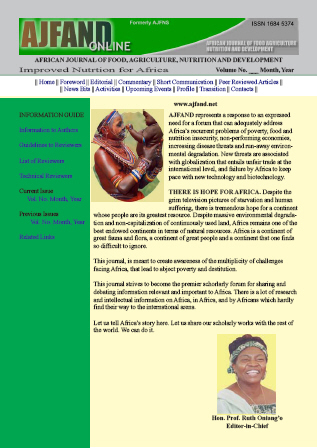
|
African Journal of Food, Agriculture, Nutrition and Development
Rural Outreach Program
ISSN: 1684-5358
EISSN: 1684-5358
Vol. 14, No. 4, 2014, pp. 1981-1991
|
 Bioline Code: nd14039
Bioline Code: nd14039
Full paper language: English
Document type: Research Article
Document available free of charge
|
|
|
African Journal of Food, Agriculture, Nutrition and Development, Vol. 14, No. 4, 2014, pp. 1981-1991
| en |
EFFECT OF STAGE OF LACTATION ON THE PHYSICAL AND CHEMICAL COMPOSITION OF DRÂA GOAT MILK
Noutfia, Y.; Zantar, S.; Ibnelbachyr, M.; Abdelouahab, S. & Ounas, I.
Abstract
Raw milk characterization constitutes a preliminary and an important step to take
account in order to obtain an optimal technological valorization. Among other factors,
breed, feed and stage of lactation are the most important factors that influenced cheese
making and other dairy products valorization. Thus, this study proposes to analyze the
physicochemical composition of Drâa goat milk and to study raw milk fluctuations
throughout a complete lactation period. The study was carried out in the Experimental
Station of Errachidia (Southern Morocco). In this context, sixteen goats were selected
and sampled every week during a period of 160 days (average lactation length). A
total of 128 samples of raw goat milk were analyzed according to international
standards. Analyses were focused to determination of pH, acidity, density, Dry Matter
(DM), Solids Non Fat (SNF), ash, fat and Total Nitrogenous Matter (TNM). Average
values were about 17.8°D for acidity, 13.3% for Dry Matter, 0.73% for ash, 4.16% for
fat and 3.60% for Total Nitrogenous Matter. In general, theses values are largely
situated in the upper level of the range suggested by several Moroccan and foreign
researchers for other goat species. On the other hand, the evolution of physical and
chemical parameters throughout lactation stages showed that dry matter, fat content
and total nitrogenous matter increased significantly throughout the lactation period;
the opposite was found for density (p<0.001). No significant (p>0.05) changes were
shown for milk acidity and the average found was around 17°D. Content of milk ash
increased significantly during the late lactation stage compared to the earliest and the
opposite was observed for pH.The results of the present investigation show that Drâa
goat milk is rich with desirable components like fat and protein for dairy product
manufacturers, and that the late lactation stage seems to be the best period to ensure
an optimum technological valorization.
Keywords
Goat; Morocco; milk; physicochemical; lactation
|
| |
© Copyright 2014 - African Journal of Food, Agriculture, Nutrition and Development
Alternative site location: http://www.ajfand.net/
|
|
